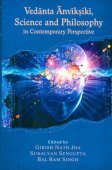Mulavidya, Mula-vidya, Mūlavidyā: 9 definitions
Introduction:
Mulavidya means something in Buddhism, Pali, Hinduism, Sanskrit. If you want to know the exact meaning, history, etymology or English translation of this term then check out the descriptions on this page. Add your comment or reference to a book if you want to contribute to this summary article.
In Hinduism
Shaktism (Shakta philosophy)
Source: Google Books: The Yoginihrdaya, a Sanskrit Tantric TreatiseMūlavidyā (मूलविद्या) (or Bhairavī) refers to one of the Nine Vidyās (presiding over the nine parts of the Śrīcakra), according to the Yoginīhṛdaya (one of the principal works of Tantric Hinduism).—Accordingly, “The first is the Karaśuddhikarī, the second one Ātmarakṣikā, the third Ātmāsanagatā; then, after her, [comes] Cakrāsanagatā, then Sarvamantrāsanasthitā. Sādhyasiddhāsana is the sixth one, her nature being that of Māyā and Lakṣmī, supreme. The one called Mūrtividyā is the seventh goddess. The eighth one is the vidyā Āvāhinī; the ninth is the supreme Bhairavī, also called Mūlavidyā, subjugating the three worlds”.
Source: Google Books: ManthanabhairavatantramMūlavidyā (मूलविद्या) refers to the “root vidyā”, according to the Ṭīkā (commentary) on the Manthānabhairavatantra, a vast sprawling work that belongs to a corpus of Tantric texts concerned with the worship of the goddess Kubjikā.—Accordingly, “How is the root Vidyā [i.e., mūlavidyā]? (Navātman) is linked with the goddess Samayā (and they) form a couple that pervades the lineages of the Child and the other (lineages). (This couple is) common to all (of them) and is undivided. This is the meaning. ‘The couple which consists of the root Vidyā’... etc. And it is that, namely, the form of Navātman along with the root Vidyā, that is, the goddess Samayā who pervade the three lineages as a couple. [...]”.

Shakta (शाक्त, śākta) or Shaktism (śāktism) represents a tradition of Hinduism where the Goddess (Devi) is revered and worshipped. Shakta literature includes a range of scriptures, including various Agamas and Tantras, although its roots may be traced back to the Vedas.
General definition (in Hinduism)
Source: Hindupedia: The Hindu EncyclopediaMūlavidyā (मूलविद्या).—There are four main or mūla-vidyās in Śrī-vidyā:
- Gāyatri: Vedic Gāyatri, the primary Vidyā that one is initiated into, before the Śrī-Vidyā mantras like Bāla or Pancadāsi.
- Bāla: The three lettered Vidyā. The presiding devata, Bāla Mahā Tripura Sundari, is a child. Bāla is said to be one of the most attractive and wonderful forms of Devi.
- Pancadāsi: Pancadāsi is the famous fifteen lettered Śrī-Vidyā mantra. Dakśiṇamūrti is said to be the seer of Pancadāsi.
- Śodasi: Śodasi is the sixteen lettered Śrī-Vidyā. Pancadāsi with an additional bīja (usually Śrībīja) becomes Śodasi.
In Buddhism
Mahayana (major branch of Buddhism)
Source: De Gruyter: A Buddhist Ritual Manual on AgricultureMūlavidyā (मूलविद्या) refers to the “root spell” according to the Vajratuṇḍasamayakalparāja, an ancient Buddhist ritual manual on agriculture from the 5th-century (or earlier), containing various instructions for the Sangha to provide agriculture-related services to laypeople including rain-making, weather control and crop protection.—Accordingly, [as the Bhagavān teaches the offering of the root spell], “From here onwards I will teach the offering of the root spell (mūlavidyā) esteemed by the Nāgas. Having enchanted a mixture of mustard seeds and parched grain with this Blazing Garuḍa Power heart-dhāraṇī, and having first looked up to the sky at the sphere of clouds, [the mixture] should be thrown in the four directions. All clouds and thunderbolts will be paralysed. All Nāgas will stand trembling. [...]”.

Mahayana (महायान, mahāyāna) is a major branch of Buddhism focusing on the path of a Bodhisattva (spiritual aspirants/ enlightened beings). Extant literature is vast and primarely composed in the Sanskrit language. There are many sūtras of which some of the earliest are the various Prajñāpāramitā sūtras.
Languages of India and abroad
Sanskrit dictionary
Source: DDSA: The practical Sanskrit-English dictionaryMūlavidyā (मूलविद्या).—the twelve-worded (dvādaśākṣarī) spell :-- ओं नमो भगवते वासुदेवायः (oṃ namo bhagavate vāsudevāyaḥ); जुहुयान्मूलविद्यया (juhuyānmūlavidyayā) Bhāgavata 8.16.4.
Mūlavidyā is a Sanskrit compound consisting of the terms mūla and vidyā (विद्या).
Source: Cologne Digital Sanskrit Dictionaries: Aufrecht Catalogus CatalogorumMūlavidyā (मूलविद्या) as mentioned in Aufrecht’s Catalogus Catalogorum:—See Śrīvidyākhyamūlavidyābhedāḥ.
Source: Cologne Digital Sanskrit Dictionaries: Monier-Williams Sanskrit-English DictionaryMūlavidyā (मूलविद्या):—[=mūla-vidyā] [from mūla > mūl] f. ‘principal science’, Name of a [particular] Mantra (= dvādaśākṣara q.v. [Scholiast or Commentator]), [Bhāgavata-purāṇa]
[Sanskrit to German]
Sanskrit, also spelled संस्कृतम् (saṃskṛtam), is an ancient language of India commonly seen as the grandmother of the Indo-European language family (even English!). Closely allied with Prakrit and Pali, Sanskrit is more exhaustive in both grammar and terms and has the most extensive collection of literature in the world, greatly surpassing its sister-languages Greek and Latin.
See also (Relevant definitions)
Starts with: Mulavidyavinashaka.
Full-text: Bhairavi, Mulamantra, Karashuddhikari, Atmarakshika, Cakrasanagata, Sadhyasiddhasana, Avahini, Atmasanagata, Sarvamantrasanasthita, Murtividya, Avahinividya.
Relevant text
Search found 5 books and stories containing Mulavidya, Mula-vidya, Mūlavidyā, Mūla-vidyā; (plurals include: Mulavidyas, vidyas, Mūlavidyās, vidyās). You can also click to the full overview containing English textual excerpts. Below are direct links for the most relevant articles:
Shat-cakra-nirupana (the six bodily centres) (by Arthur Avalon)
Verse 42 < [Section 7]
The Shiva Purana (by J. L. Shastri)
Chapter 13 - The greatness of the five-syllabled Mantra (2) < [Section 7.2 - Vāyavīya-saṃhitā (2)]
Reviews < [October 1964]
The Skanda Purana (by G. V. Tagare)
Chapter 20 - The Nirguṇatva of the Śiva Liṅga: The Manifestation of Bhavānī < [Section 1 - Kedāra-khaṇḍa]
Chapter 11 - Procedure of Gaṇeśa Worship: Manifestation of Lakṣmī < [Section 1 - Kedāra-khaṇḍa]
Shakti and Shakta (by John Woodroffe)
Chapter XXXI - Conclusions < [Section 4 - Yoga and Conclusions]
Chapter XIX - Creation as explained in the non-Dualist Tantras < [Section 2 - Doctrine]
Related products

